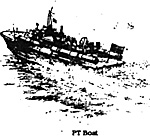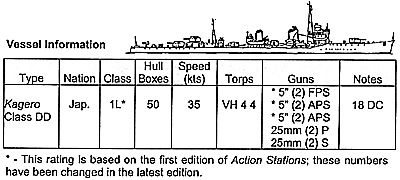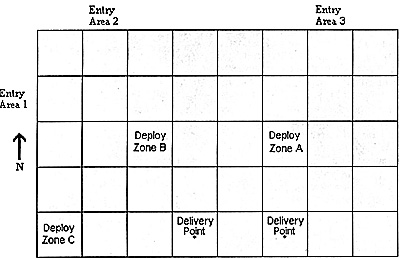 Note: This scenario was designed for play with the Action Stations! quick play coastal forces rules, which are again available through Brookhurst Hobby. However, it may be played with almost any set of naval rules that include rules for PT boats.
Note: This scenario was designed for play with the Action Stations! quick play coastal forces rules, which are again available through Brookhurst Hobby. However, it may be played with almost any set of naval rules that include rules for PT boats.
Introduction
During the Solomon Islands campaign American PT boats and Japanese destroyers fought on a frequent basis. Most of these clashes were the result of the Japanese High Command's decision to use destroyer convoys to move troops and supplies through the islands. Destroyers were chosen because of their speed and ability defend themselves against all but the heaviest American ships. The Americans referred to these high-speed destroyer convoys as the "Tokyo Express." The following scenario is based on an encounter between the Tokyo Express and the PT boats near Guadalcanal in late 1942. The scenario was designed for two Japanese and three American players, but it could be played with fewer players.
Japanese Orders
You are in command of the Reinforcement Unit that is taking supplies to the troops on Guadalcanal. The unit was originally composed of seven destroyers, but an air attack by American dive-bombers from Henderson Field damaged two destroyers and they have been sent back to Rabaul with an undamaged destroyer as an escort.
Of the remaining destroyers, three are carrying supplies, while the fourth is acting as escort. The supplies are loaded in empty drums, which have been lashed together in groups of fifty to form drum strings. The drum strings must be dropped close to shore (near the Delivery Points shown on the map) so that our troops can drag them ashore. They are in desperate need of the supplies and you must do your utmost to ensure delivery.
Your destroyers may enter from any of the entry areas shown on the map edge. All of the supply destroyers must enter from the same area; the escort destroyer may enter with the supply destroyers or in any other area. After dropping off the supplies, all destroyers should exit the map on the north or west side.
Japanese Forces
All destroyers are Kagero class (stats at end of article)
Supply Destroyers: Kagero, Kuroshio, Oyashio
Escort Destroyer: Arashi
American Orders
You are the commander of a unit of six PT boats with orders to patrol the waters off Guadalcanal. Coast watchers have reported that the Tokyo Express is making a run down the slot with seven destroyers. Marine SBDs from Henderson Field attacked the Japs just before dusk. They claim to have sunk one destroyer and damaged four others, but you can't always depend on pilot reports. The Japs could be on a supply mission, a bombardment mission, or they just may be out to cause trouble. In any case, your job is stop whatever is coming.
Your PT boats must be deployed in pairs and can start in any of the Deployment Zones shown on the map. There can be no more than four PT boats in any one zone.
American Forces
77' Elco class PTs: PT-37, PT-40, PT-44, PT-48
80' Elco class PTs: PT-109, PT-114
Special Rules
1. Both sides must plot movement for their ships for the first 15 turns before the game starts (These pre-plotted orders are just to prevent each side from reacting to the enemy before they really spot them). The turn after the enemy is sighted all friendly ships are free to move as desired.
2. All crews are average with normal leaders.
3. Each of the three supply destroyers is each carrying five drum strings and these destroyers do not carry torpedo reloads. The drum strings are dropped off a destroyer, one string per turn, after movement. A destroyer must be moving at 5 knots or less when dropping drum strings.
4. The scenario is over when all the ships from one side are sunk or have exited the map.
Map
The scenario was designed to be played on an 8' x 5' table; this can be varied to fit what you have. It is recommended that each side only see the points that are relevant to it (the American only see the Deploy Zones, and the Japanese only see the Entry Areas and Delivery Points).
Victory Conditions
The Japanese side receives these Victory Points during the game:
- Each Hull hit on a PT boat = 1 pt.
Each PT boat sunk = 10 pt.
Each drum string dropped within 6" (15cm) of a Delivery Point = 10 pt.
Each drum string dropped 6-12" (15-30cm) of a Delivery Point = 5 pt.
No points are awarded for drum strings dropped greater than 12" (30cm) from a Delivery Point.
The American side receives these Victory Points during the game:
- Each Japanese ship sunk or unable to exit the map = 40 pt.
Each Japanese ship reduced to less than 1/2 original speed = 15 pt.
Subtract the American total from the Japanese total and compare the result to the Victory Levels below:
- under 30 points = Decisive American
31 - 60 points = Tactical American
61 - 80 points = Draw
81 - 100 points = Tactical Japanese
over 100 points = Decisive Japanese
Action Stations Information
Recommended Sighting Distances
| Size Class | Under 10 kts | 10 - 19 kts | 20+ kts |
|---|---|---|---|
| 1* Destroyers | 38cm | 58cm | 58cm |
| 3* PT boats | 23cm | 33cm | 53cm |
Friendly Fire Rule
This rule is an optional addition to the Action Stations! rules. It is meant to add a little more danger to firing at enemy ships that have friendly ships on the other side of them.
When all of the following conditions exist there is a chance that a friendly fire incident will occur:
- A friendly ship, the target ship, and the friendly firing weapon are all in a direct line with each other. The friendly ship is always further from the firing weapon than the target.
The friendly ship is in range of the friendly firing weapon.
The gun attack by the friendly firing weapon missed the enemy ship.
If all the conditions are met roll a d10, on a roll of 1 the friendly ship is hit. Roll normally to determine hit location and damage.

MAP

Back to Citadel Spring 2001 Table of Contents
Back to Citadel List of Issues
Back to MagWeb Master Magazine List
© Copyright 2001 by Northwest Historical Miniature Gaming Society
This article appears in MagWeb (Magazine Web) on the Internet World Wide Web. Other military history articles and gaming articles are available at http://www.magweb.com